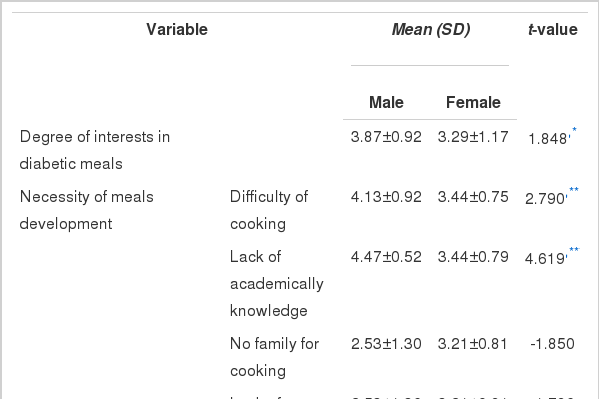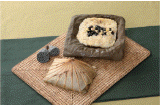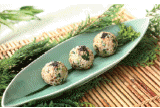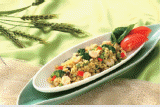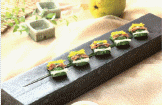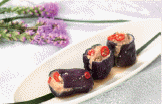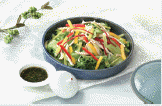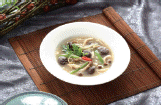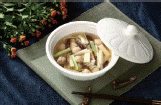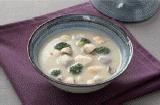당뇨병환자의 메뉴개발 요구도 및 보리이용 당뇨식단 개발
Need for Development of a List of Meals for Diabetic Patients and Development of Barley-Based Diabetic Meals
Article information
Trans Abstract
The aim of this study was to develop and apply a list of meals and standard recipes using barley for diabetic patients. The degree of interest and requirements of diabetic patients were investigated for the development of meals. The ingredients of the meals were selected through the diabetic literature and previous research. While developing a list of meals, dietetic therapies for diabetic patients were considered. After developing 15 kinds of meals and modifying them through sensory evaluation, a standard recipe was completed. In the standard recipe, the menu name, the ingredients, quantity, and recipe were stated and the nutritional components were indicated. Photographs of the meals were included. The calorie prescription for the diabetic patients was aimed at elderly women, that is, those 65 years old or above, based on research showing this to be the average age of diabetics. The prescribed calories were 1,500 kcal based on the food exchange list. Weekly lists of meals including the developed dishes were made for diabetic patients. The list were modified after consultation with a clinical nutritionist. When completed, one meal item was selected for each day and cooked. A photograph was taken and presented diabetic patients. This article presents the standardized recipes of the developed list of meals and applies them to modifying the diabetic diet, with an aim to be of service to diabetic patients attempting to meet their dietetic therapy goals. We also provide basic data on institutional food services for diabetic patients and nutrition education.
서 론
생활수준의 향상과 식생활이 서구화 되면서 발병률이 증가되고 있는 당뇨병, 고혈압, 동맥경화증 등은 환자 개인뿐만 아니라 국가적 의료비 증가를 가져오는 국민보건상의 중요한 문제로 대두되고 있다. 보건복지부의 국민건강영양조사 결과에 따르면 우리나라의 만 30세 이상의 당뇨병 유병률은 2001년 8.6%에서 2007년 9.6%로 증가하였으나 2010년 10.1%로 남자 11.3%, 여자 9.0%로 남자가 더 높은 것으로 보고 되었다[22]. 당뇨병환자는 섭취하는 식품의 선택과 식습관에 따라 혈당반응의 차이가 크게 나타나기 때문에 혈당관리에 있어서 식이요법이 필수적이다. 식이섭취 및 식습관에 관한 연구에서 당뇨병환자는 식사속도가 빠르고 과식하는 경향이 있으며 밥 양과 육류의 기름기를 많이 섭취하는 것으로 조사되었고[8], 과반수이상이 식사시간이 불규칙하고 식사를 거르는 경우 간식으로 지방함유율이 높은 음식을 섭취하며 비타민과 무기질 같은 미량영양소의 섭취는 적다고 보고하였다[3]. 또한, 당뇨병환자는 기존의 치료방법과 식이요법 외에도 건강기능식품이나 대체요법에도 많은 관심을 보이고 있다[6, 27]. 그러나 이러한 방법들 가운데는 과학적으로 효과가 입증되지 않은 민간요법들이 포함되어 있어 오남용 할 경우 증상을 더욱 악화시키고 합병증을 유발하는 등의 부작용을 초래할 수 있다[24].
지금까지 보고된 보리관련 선행연구에 따르면 보리는 항당뇨 및 혈당조절 효과가 있는 것으로 알려져 있다. 보리는 분자량이 크고 수용성의 점성이 매우 높은 성분인 β-glucan을 함유하고 있는데, 이는 소화흡수에 관여하여 혈당을 조절하는 기능을 나타낸다[16]. 이 밖에도 β-glucan은 항산화효과 및 항암활성[18, 28], 항돌이변이원성[19], 면역증강[25], 콜레스테롤 감소효과[32]를 비롯하여 혈당조절 및 지질대사에 긍정적 영향을 미친다는 연구결과[34]가 있다.
현재 보리의 기능성에 관한 연구로는 in vitro 실험을 통해 보리 또는 그 추출물이 혈당조절 효과를 나타내는지에 대한 연구와[20, 30], 보리를 이용한 단일식품 급여가 혈당변화에 미치는 영향에 대한 연구[13-15, 34] 등이 있으나 보리를 환자의 치료식이나 식이요법에 적용한 연구사례는 미흡한 실정이다.
따라서 본 연구에서는 당뇨병환자에게 기존 메뉴를 활용한 식단을 작성하여 환자에게 적용한 기존의 연구 형태와는 달리, 보리를 첨가하거나 가공한 메뉴를 개발하고, 이를 식단에 포함시킴으로서 실제로 당뇨병환자가 이용가능한 일주일 분의 식단을 제안하고자 하였다.
연구방법
1. 당뇨병환자의 메뉴개발 요구도
1) 조사대상자 및 조사기간
조사대상은 전북지역의 당뇨병 이환노인 50인으로 병·의원에서 당뇨병을 진단 받은 환자를 대상으로 하였다. 조사대상자는 남자 30.6%, 여자 69.4%이며 평균연령은 남자 66.0세, 여자 65.9세이었다. 조사기간은 2010년 7월 13일-7월30일까지 이루어졌으며 조사는 병원의 담당 임상영양사가 연구원과 함께 조사를 하였으며 설문지를 회수하여 분석에 이용될 수 없는 것을 제외한 49부(98%)를 분석에 사용하였다.
2) 설문조사 내용 및 분석방법
설문지는 선행연구[21, 33]를 참고하여 본 연구목적에 맞게 수정하였으며 당뇨식단에 대한 관심정도, 당뇨식단 필요이유, 당뇨식단 개발 시 중요속성, 조리법별 개발 요구도로 구성하였다. 본 조사결과는 Likert 5점 척도로 ‘매우 그렇다’ 5점-‘전혀 그렇지 않다’ 1점으로 점수화하였다. 설문조사 시에는 대상자의 이해수준을 고려하여 질문자가 직접 질의하는 방식으로 이루어졌다. 수집된 자료의 통계처리는 SPSS ver. 12.0 (SPSS Inc., Chicago, IL, USA)을 이용하여 평균, 표준편차를 구하고, 남녀차이에 대해 t-test로 통계적 유의성을 검증하였다. 조사도구의 신뢰도 검정을 실시하였으며 당뇨식단 필요이유의 Cronbach’s alpha값은 0.723이었으며, 당뇨식단 개발 시 중요속성의 Cronbach’s alpha값은 0.967, 조리법별 개발 요구도의 Cronbach’s alpha값은 0.965이었다.
2. 보리이용 메뉴 및 당뇨식단 개발
1) 식재료에 관한 문헌고찰
메뉴개발에 이용된 보리를 제외한 식재료는 문헌고찰[5, 11]을 통해 효능과 조리과학적 특성을 확인하였고, 당뇨병식단과 관련한 서적과 선행연구[12, 17, 26, 29]를 참고하여 선별하였다.
2) 메뉴개발의 원칙
보리를 이용한 메뉴는 주식, 부식, 국·찌개로 분류하였고, 열량을 낮추는 조리법과 당뇨식 조리원칙에 따라 저열량, 저염, 저지방의 영양소로 구성하였으며 당뇨를 예방할 수 있는 식재료를 포함하도록 메뉴를 개발하였다. 개발된 메뉴는 조리의 재현성을 위해 당뇨병환자 및 보호자뿐만 아니라 일반인이 따라 하기 쉬운 조리법을 선택하였다. 환자의 급격한 혈당상승을 억제하기 위하여 주식은 흰밥이나 죽류를 배제하고 잡곡밥이나 섬유소 함량이 높은 식품을 위주로 첨가하였다. 메뉴에 대한 환자의 기호도를 높이기 위하여 양념류를 향신료나 식초, 인공감미료 등으로 대체하여 사용하였다. 식재료와의 조화에 있어서는 생보리와 보리가루를 메뉴를 포함시킬 경우 음식 재료와 부조화를 이루거나 음식의 맛에 거부감을 줄 수 있는 메뉴는 배제하였으며 소금의 사용은 최소한으로 하고 식재료 자체의 염분을 이용하는 것으로 원칙으로 하였다.
3) 보리이용 메뉴개발 및 전문가 평가
메뉴는 다수의 예비조리를 통해 일정한 재료의 분량과 조리방법을 일차적으로 결정하고, 조리된 메뉴를 임상영양 및 교육, 단체급식, 조리과학 및 식품가공 분야의 전문가 10명이 평가한 후 최종적으로 개발메뉴를 완성하였다. 평가는 맛, 모양, 영양적 균형 및 식재료의 조화의 4가지 항목에 대해 Likert 5점 척도(5점 매우 좋다-1점 매우 좋지 않다)로 평가한 후 그 결과를 반영하여 조리법을 수정·보완하였다. 통계처리는 SPSS ver. 12.0을 이용하여 one-way ANOVA를 실시하여 집단별로 유의한 차이를 분석하였다. 개발메뉴는 조리가 가능한 식재료의 최소량을 고려하여 4인을 기준으로 하였으며, 메뉴명, 식재료 및 분량, 조리법을 명시하였다.
개발된 메뉴는 한국영양학회에서 고안한 영양분석 프로그램 CAN pro (computer aided nutritional analysis program) 3.0을 이용하여 4인 기준 분량에 25%의 섭취율을 적용하여 열량 및 당질, 단백질, 지방, 식이섬유, 나트륨, 콜레스테롤 함량을 산출하였다.
4) 보리이용 메뉴를 이용한 당뇨식단 개발
보리를 이용하여 개발된 메뉴는 실제적인 당뇨병환자의 식단에 활용하고자 일일 식단의 열량을 1,500 kcal로 구성하여 환자에 맞게 열량 조절이 가능하도록 1주일분 당뇨식단을 작성하였다. 작성된 당뇨식단은 전북 소재 대학병원의 임상영양사의 자문을 받아 완성하였다.
식품교환표의 단위 수를 계산하여 산출된 3대 영양소 비율은 당뇨병 진료지침의 임상영양요법에서 권고한 탄수화물, 단백질, 지방의 섭취비율인 50-60%:15-20%:25%를 벗어나지 않도록 하였으며[17], 당뇨병환자의 경우 아침에 인슐린저항이 상승하는 증상을 고려하여[1] 아침식사의 양은 점심식사와 저녁식사에 비해 적게 섭취하도록 식사의 양을 배분하였다. 1끼 식단에는 개발메뉴가 2가지 이상 포함되도록 구성하고, 식품군의 구성은 채소류 3단위(1,500 kcal의 경우 2.5단위로 배분), 어육류 2단위가 반드시 포함되도록 하고, 간식을 섭취하는 경우 당질의 함량을 최소화 하기위해 탄수화물로 이루어진 간식은 제한하도록 하였다. 보리가 주재료가 아닐 경우 양념이나 소스에는 10 g 이하로 포함되도록 하였다.
당뇨식단은 일별로 영양분석을 실시하여 열량, 탄수화물, 단백질, 지질, 콜레스테롤, 비타민B1, 비타민C, 칼슘, 철분, 나트륨, 식이섬유의 함량과 3대 영양소비율(%)을 한국인영양섭취기준[31]과 비교가 가능하도록 하였다. 완성된 식단은 일별로 개발메뉴가 포함되어 있는 1끼의 식단을 선정하고 식단의 균형을 위해 간식을 추가 구성하였다.
연구결과 및 고찰
1. 당뇨병환자의 메뉴개발 요구도
조사대상자의 당뇨식단 개발에 대한 요구도는 Table 1과 같다. 당뇨식단에 대한 관심도는 남자 3.87점, 여자 3.29점으로 남자의 관심도가 유의적으로 높았다(p<.05).당뇨식단 개발의 필요성에서는 조리의 어려움(p<.01)과 전문지식의 부족(p<.001) 항목에서 유의적 차이를 보였다. 조리가 어려움은 남자 4.13점, 여자 3.44점로 남자가 조리의 어려움을 더 느끼는 것으로 나타났다. 전문지식의 부족도 남자 4.47점, 여자 3.44점으로 남자가 더 높게 나타났다. 조리할 사람 없음과 조리시간 부족은 각 항목에 대해 남자 2.53점, 여자 3.21점으로 여자가 높게 나타났지만 유의적인 차이는 없었다.
당뇨식단을 개발할 때의 중요속성에 대해서는 조미료 무첨가 항목을 제외한 맛(p<.001), 영양성분 표시(p<.01), 위생(p<.001), 청결한 포장상태(p<.001), 국내산 재료사용(p<.001), 보관의 용이성(p<.01), 메뉴의 다양성(p<.01), 기호도 반영(p<.01), 구매의 용이성(p<.01)의 모든 항목에서 유의적인 차이를 보였고, 중요도 점수도 ‘조미료 무첨가’ 항목을 제외한 모든 항목에서 남자가 높게 나타났다.
가정배달 치료식 개발에 대한 연구에서 식사요법 실천의 제한요인으로 환자만을 위한 별도의 조리에서 오는 번거로움을 가장 큰 어려움으로 평가하였고, 그 다음으로는 제한된 조리법과 식재료 맛의 하락, 치료식 조리방법의 어려움이라고 보고하였다[33]. 본 연구에서도 당뇨병식단을 이용 시 그 이유에 대해 전문지식 부족과 조리의 어려움이 높게 나타나 이러한 요인이 개별적으로 식사요법 실천을 어렵게 하기 때문에 외부에서 제공되는 당뇨병식단에 대해 높은 기대를 보인 것으로 판단된다.
조리법에 따른 개발 요구도는 밥·죽류에 대해 남자 4.00, 여자 3.18로 남자가 높아 유의적인 차이를 보였다(p<.05). 조사대상자 중 남성의 경우 대체로 식사를 직접 조리하지 않고 외식 빈도가 여성보다 많기 때문에 당뇨병식단에 대한 관심정도가 높게 나타난 것으로 판단된다. 개발 요구도가 높게 나타난 메뉴는 밥·죽류로 메뉴개발 시 주식에 초점을 맞추었으며, 맛, 영양성분 표시, 위생, 국내산 재료사용, 메뉴의 다양성 등을 고려하였다.
2. 보리이용 당뇨식단 개발
1) 보리이용 메뉴개발
메뉴개발을 위하여 선별된 식재료는 곡류·두류·서류에서는 보리, 현미, 찹쌀, 밀, 완두콩, 두부, 토란이며 채소류에서는 애호박, 단호박, 고추, 가지, 오이, 피망, 브로콜리, 당근, 배추, 양배추, 양상추, 무청, 쑥갓, 아욱, 숙주나물, 표고버섯, 양송이버섯, 느타리버섯, 팽이버섯, 양파 등이다. 어육류는 새우, 닭고기, 돼지고기, 쇠고기, 계란이며, 해조류는 곤약, 다시마, 과일류는 배, 감, 키위, 견과류로는 흑임자, 참깨, 은행, 밤, 대추, 잣, 들깨를 선별하였다. 양념류는 카레, 참기름, 간장, 된장, 후추, 겨자, 식초 등이다.
현미는 탄수화물 대사에 필요한 비타민 B1이 풍부하고[23] 콩류와 두부는 여성호르몬과 유사한 기능을 하여 골다공증, 유방암, 자궁암, 난소암 등의 여성 질환 발생을 감소시키는 isoflavone [9], 천연 혈당강하효과를 나타내는 pinitol [4], 무기질과 결합된 형태로 존재하여 산화반응을 억제와 항암작용을 하는 phytic acid [2] 등의 생리활성물질을 함유한 것으로 보고되었다. 채소류는 식이섬유의 함량이 높아 혈당과 혈중지질의 농도를 낮추고 비교적 열량이 낮기 때문에 당뇨환자의 1끼 식단에 3단위 이상이 포함되도록 권장하고 있다[17]. 채소류 중 1단위당 6 g 이상의 당질을 함유한 고춧잎, 연근, 우엉, 쑥, 풋마늘 등은 메뉴개발에 포함되지 않도록 하였다[17]. 항산화기능을 가진 것으로 널리 알려진 파, 마늘, 양파 등의 allium속 채소류는 황 휘발성 물질을 함유하여 특유의 독특한 향과 함께 항암활성 및 암세포 증식억제효과[7], 항균활성[3] 등이 보고되어 있다. 고추가 함유한 capsaicin 성분은 체액성면역 증강작용, 암유전자 발현 조절작용의 기능을 하는 것으로 보고되었으며[35] 이들 식품을 활용한 다양한 메뉴가 개발되어 있다. 저열량·고식이섬유의 대표적 식품으로 이용률이 높은 버섯류는 느타리버섯, 양송이버섯, 표고버섯, 영지버섯, 송이버섯, 팽이버섯 등이 있는데, 혈중 콜레스테롤 농도 저하효과, 항동맥경화 효과 등의 생리활성이 보고되어 있다[10]. 해조류는 바다에서 나는 채소라 할 만큼 비타민과 무기질이 풍부하고 암 예방과 치료, 저급콜레스테롤을 제거하는 성분을 함유하고 있으며, 곤약은 대부분 식이섬유로 이루어져 있고 열량이 거의 없기 때문에 포만감을 높일 수 있는 식품이다[11].
음식에 양념으로 사용되는 조미료는 식사조절이 중요한 당뇨환자의 식단구성에 있어서 식욕을 돋우고 식사요법을 지속하게 하는 요소이다. 짠맛을 내는 조미료로는 소금 대신 간장, 된장 등을 이용하거나 식재료 자체의 짠맛을 이용할 수 있는 마른 새우, 멸치, 다시마 등을 이용하여 맛을 낼 수 있다. 단맛을 낼 때는 설탕을 피하고 저열량 감미료나 급격한 혈당상승을 막는 올리고당을 대체하여 사용한다. 신맛은 미각을 자극하여 짠맛과 단맛을 보완하여 식욕을 돋운다[11]. 이 같은 식재료를 이용하여 개발한 메뉴는 Table 2와 같다.
2) 전문가 평가
개발된 메뉴에 대하여 총 10명의 전문가가 개별 메뉴의 전반적인 평가 및 개선방안을 Table 3과 4에 제시하였다. 메뉴에 대한 평가결과 보리수제비를 제외한 모든 메뉴의 평가 값은 5.0점 기준으로 4.0점 이상으로 높은 경향을 보였다. 맛의 항목에서는 보리겨자드레싱샐러드가 가장 높은 평가를 받았고, 모양, 영양적 균형, 식재료 조화의 항목에서는 보리곤약잡채의 평가가 가장 높았으나 평가항목별 메뉴간의 유의적인 차이는 없었다. 메뉴평가 시 각 분야의 전문가들에 의해 수집된 의견을 바탕으로 메뉴를 수정 보완하였다.
3) 당뇨식단의 예
당뇨식단은 활동량이 많지 않은 60세 이상의 노인을 대상으로 1,500 kcal을 기준으로 하였다(Table 5). 식품교환표의 단위 수를 계산하여 산출된 3대 영양소 비율은 탄수화물 55.1%, 단백질 20.0%, 지방 24.9%로 당뇨병 진료지침의 임상영양요법에서 권고한 섭취비율 기준을 벗어나지 않는 비율이었다.
당뇨병환자가 식단에서 이용할 수 있도록 개발메뉴 15가지를 포함한 1주일 식단의 예는 Table 6과 Figure 1에 제시하였다. 1일째 식단은 개발된 메뉴 중 부식 1종, 국·찌개 1종이 포함되었고, 2일째 식단은 주식 1종, 국·찌개류 1종, 3일째 식단은 주식 1종, 국·찌개 1종, 4일째 식단은 부식 2종, 5일째 식단은 주식 1종, 부식 1종, 6일째 식단은 주식 1종, 부식 1종, 7일째 식단은 주식 1종, 부식 1종, 국·찌개 1종으로 총 15가지의 메뉴가 모두 포함되었다.
결 론
본 연구는 당뇨병환자를 대상으로 환자 메뉴개발에 대한 요구도 조사를 통하여 보리이용 메뉴와 조리법을 개발하고 이를 당뇨병환자의 일주일 식단계획에 적용함으로써 그 활용도를 높이는데 목적이 있다.
조사대상자는 대부분 65세 이상 노인기의 당뇨병환자로서 대체로 당뇨식단 개발에 대한 관심정도가 높은 경향이었다. 남성의 경우 대체로 식사를 직접 조리하지 않고 전문지식이 높지 않기 때문에 당뇨식단에 대한 관심정도와 구매의향이 높게 나타났다. 개발 필요성이 높게 나타난 메뉴는 밥·죽류로 메뉴개발 시 주식에 초점을 맞췄으며, 맛, 영양성분 표시, 위생, 국내산 재료사용, 메뉴의 다양성 등을 고려하여 메뉴를 개발하였다.
메뉴개발은 문헌과 선행연구 고찰을 통해 식재료를 선별하고, 당뇨병의 식사요법과 조리 시 주의사항을 고려하여 주식, 부식, 국·찌개의 3종류로 분류하여 메뉴를 개발하고 총 15가지 메뉴를 선별하였다: 보리연잎밥, 단호박보리찜밥, 보리주먹밥, 카레새우보리볶음밥, 보리수제비, 매실보리소스오이선, 보리섭산적, 가지돼지고기조림, 보리곤약잡채, 당조닭가슴살샐러드, 보리겨자드레싱샐러드, 보리새우아욱국, 버섯보리들깨국, 닭고기보리완자전공, 보리알토란탕. 예비조리를 통해 일차적으로 완성된 메뉴는 임상영양, 단체급식, 조리과학, 식품가공 분야의 전문가를 통해 각 개발메뉴에 대해 맛, 모양, 영양적 균형 및 식재료의 조화에 대한 평가를 실시하였으며, 평가 후 의견을 수집하여 조리법을 수정·보완하고 메뉴의 조리법을 최종적으로 완성하였다. 이상의 개발된 메뉴는 영양분석 프로그램을 이용하여 영양성분 함량을 표시하였다.
당뇨병환자가 식단에서 이용할 수 있도록 개발메뉴를 1일 2가지 이상 포함한 일주일분의 당뇨식단을 작성하였다. 당뇨병의 임상영양요법과 식품교환표를 활용하여 식단을 작성한 후 현직 임상영양사의 자문을 받아 수정 보완하여 식단을 완성하였다. 식단에 대한 이해도를 높이기 위해 개발메뉴가 포함된 한 끼 식단을 직접 조리하여 사진으로 제시하였다.
본 연구에서는 많은 선행연구를 통해 기능성이 입증된 보리를 이용하여 메뉴를 개발하고, 개발메뉴를 당뇨식단에 포함시켜 실제 당뇨병환자가 개발메뉴를 식단에 활용할 수 있도록 함으로써 식사요법 실행에 도움이 될 수 있을 것이다. 또한 보리가 함유한 성분과 그 기능성으로는 지질대사 조절과 항산화효과를 나타냄으로서 당뇨식단 뿐만 아니라 당뇨합병증의 예방과 비만, 고혈압 등의 성인병 예방식으로 의미가 있을 것으로 생각한다. 당뇨병환자들은 전문적인 치료식 조리의 어려움이 큰 것으로 조사된 점을 볼 때 본 연구의 당뇨병환자 메뉴 요구도를 바탕으로 개발된 보리이용 메뉴와 이를 활용한 당뇨식단은 환자 본인 및 보호자의 치료식 조리의 어려움 해소에 크게 기여할 것으로 판단된다. 또한 본 연구결과는 지역의 병원이나 보건소에서 당뇨병 예방관리의 교육 자료로 활용이 가능하겠다.
Notes
The authors declared that they had no conflicts of interest with respect to their authorship or the publication of this article.
